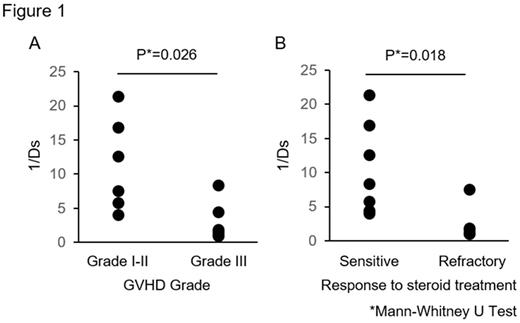Abstract
Introduction: Due to difficulty in isolating T cells from human tissues, the diversity of allo-reactive T cells that are infiltrating human acute GVHD (aGVHD) tissues remains largely uninvestigated. Here, we report the analysis of comprehensive T cell repertoire and allo-reactivity of human aGVHD tissue-infiltrating T cells.
Patients and Methods: Skin (n = 7), stomach (n = 3) and colon (n = 2) biopsy samples and blood samples (n = 8) were obtained from eight post-transplant patients when the patients were supposed to develop aGVHD and prior to the fist-line treatment of aGVHD. Total RNA was extracted from tissue and blood samples, and T cell receptor (TCR)-β gene deep sequencing was performed (~100000 reads for each sample). To estimate the TCR-β repertoire diversity, inverse Simpson's diversity index (1/Ds) were calculated. T cells were isolated from tissues and cloned by limiting dilution. This study was approved by the ethics committees of Nagoya University.
Results: In the skin of patient #1, the relative abundance of the most and second most frequent clonotypes were 74.9% and 22.8%, respectively, suggesting that only two T cell clones accounted for approximately 98% of GVHD skin-infiltrating T cells. Two T cell clones, termed clones A and B, were isolated from the skin of patient #1. Both clones lysed patient peripheral blood mononuclear cells, but failed to lyse donor cells. Thus, clones A and B were allo-reactive cytotoxic T lymphocytes (CTLs). The IFN-γ production of clone B was significantly increased when stimulated by COS cells transfected with HLA-DRB1*14:54 cDNA, suggesting that the clone B recognized the mismatched patient's HLA-DRB1*14:54 molecule. To confirm the relative abundance of clones A and B in his skin, the TCR-β usage and CDR3 were determined. Surprisingly, clones A and B were the most and second most frequent skin-infiltrating T cell clones. Taken together, these data suggested that a limited allo-reactive CTL clones were involved in GVHD development of patient #1. In all samples, the mean 1/Ds of skin, stomach, colon and all tissues were 9.4 (range, 1.2-21.3), 7.5 (1.9-14.9), 3.3 (1.0-5.5) and 7.9 (1.0-21.3), respectively, while that of all blood samples was 247 (18.8-888.7) (P < 0.01). These data indicate that the T cell repertoire in GVHD tissues was further skewed than that in peripheral blood. In the patient #4, the most frequent (92.8%) clonotype in skin accounted for only 0.029% in his stomach and 0.0092% in his colon. Likewise, the most frequent (64.4%) clonotype in stomach accounted for only 0.033% in colon, and that (99.8%) in colon was detected in neither skin nor stomach. In three patients (#2, 4 and 6) who provided multiple tissues, the 13 dominant (>10% frequency) clonotypes in a certain tissue were detected in other tissue(s) of the same patient at an extremely low frequency (<0.1% in most cases), or not detected. These data suggested that dominant clonotypes in GVHD tissue differed from tissue to tissue even in the same patient. The clonotypes in skin tissues (n = 7) were compared with each other. A few dominant (>10% frequency) clonotypes in the skin of a certain patient were detected in those of other patients with an extremely low frequency (<0.1%). For stomach (n = 3) and colon (n = 2), no dominant clonotype was commonly detected beyond the patients. These data suggested that the dominant clonotypes in a certain tissue differed from patient to patient. Finally, we examined the association between the degree of TCR repertoire skewing in tissues and clinical characteristics. The tissues from three patients with grade III aGVHD showed significantly higher skewing of TCR repertoire as compared with those from five patients with grade I-II aGVHD (mean 1/Ds, 4.4 vs. 11.5; P= 0.026) (Fig 1A). One of five patients with grade I-II aGVHD and two of three patients with grade III aGVHD required a second-line treatment. The tissues from three patients with steroid-refractory aGVHD showed significantly higher skewing of TCR repertoire as compared with those from five patients with steroid-sensitive GVHD (mean 1/Ds, 2.6 vs. 11.7; P= 0.018) (Fig 1B). Thus, the diversity of the GVHD tissue-infiltrating T cells was associated with GVHD severity and treatment response.
Conclusion: In humans, a limited allo-reactive CTL clones, which differ from tissue to tissue and from patient to patient, may induce aGVHD. The degree of skewing of tissue-infiltrating T cell repertoire may be predictive of GVHD outcome.
Kiyoi: Nippon Boehringer Ingelheim Co., Ltd.: Research Funding; Astellas Pharma Inc.: Consultancy, Research Funding; FUJIFILM Corporation: Patents & Royalties, Research Funding; Eisai Co., Ltd.: Research Funding; Meiji Seika Pharma Co.,Ltd.: Research Funding; Nippon Shinyaku Co., Ltd.: Research Funding; Sumitomo Dainippon Pharma Co., Ltd.: Research Funding; JCR Pharmaceuticals Co.,Ltd.: Research Funding; Novartis Pharma K.K.: Research Funding; MSD K.K.: Research Funding; ONO Pharmaceutical Co., Ltd.: Research Funding; Phizer Japan Inc.: Honoraria, Research Funding; Chugai Pharmaceutical Co., Ltd.: Research Funding; Bristol-Myers Squibb: Honoraria, Research Funding; Kyowa Hakko Kirin Co., Ltd.: Research Funding; Zenyaku Kogyo Co., Ltd.: Research Funding; Celgene Corporation: Consultancy, Research Funding; Takeda Pharmaceutical Co., Ltd.: Research Funding.
Author notes
Asterisk with author names denotes non-ASH members.


This feature is available to Subscribers Only
Sign In or Create an Account Close Modal